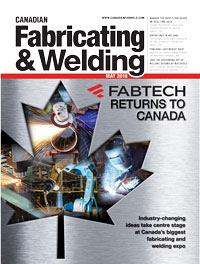Editor
- FMA
- The Fabricator
- FABTECH
- Canadian Metalworking
Punching lightweight right
Make sure your tooling is tailored to handle your application’s demands
- By Rob Colman
- May 31, 2018
- Article
- Fabricating

As shown here, heavy-duty punches have a bigger and thicker head, combined with the bigger radius under the head and the chamfer on the top to maximize the integrity and strength of the punch. Image courtesy of Wilson Tool International.
The drive to use more lightweight materials in such products as automotive parts and even washing machines is creating challenges for stamping tools. The question that fabricators must answer is, Can the tooling I am currently using handle the stress placed on it by the material that needs to be formed? Several factors determine your answer.
The Lightweighting Challenge
Martensitic and dual-phase steels “just eat up tooling,” said Jeremy Edson, product manager for the stamping and tableting divisions of Wilson Tool International®. “The tensile strength of those materials is sometimes higher than the tensile strength of the tool steels. This move to higher-strength materials has sped up in the past four or five years such that we’re seeing the adoption of these materials in a broader spectrum of products.”
Edson encourages fabricators to look carefully at the parts they are producing and the tools being used to determine if it’s necessary to invest in more advanced heavy tooling. For instance, he recommends that fabricators look for wear and microfracturing on their tools.
“When you look at your final product, you can learn a lot from how burrs are formed, where the snap-through is in the land of the cut,” Edson explained. “If you’re seeing jagged edges or a burr forming, obviously your tool is wearing. It’s a telltale sign of issues you are going to have – it may be necessary to sharpen your tools more often, or put your die down for a while so that you can get your productivity back up.”
Wearing or Breaking?
The big question is how the tool is wearing. If the tool is simply showing wear without any microfracturing, the solution to the problem may simply be to change the coating on the tooling.
“Coating technology can boost tooling performance and improve tool life by as much as seven times the normal tool life,” said Edson. “Matching your coating to your application as a strategy is often overlooked. Standard titanium nitride (TiN) or titanium carbon-nitride (TiCn) coatings have been used for quite some time, but matching the correct coating to your application will maximize efficiencies. Coatings have advanced with many different options that can provide the right fit for your application. For instance, for some high-strength steels we might consider a duplex coating combining a PVD coating with nitriding the punch. Nitriding will increase the surface hardness, and adding the PVD coating improves lubricity.”
Edson sets out several questions to ask to help you determine the best coating for your application:
- What material is being pierced or formed?
- If the product has already been run, how is the tool wearing?
- Is material adhesion or galling present?
- Is fracturing occurring on the cutting edge?
- What is the tolerance of the tools?
- Do stripping forces need to be reduced?
If you are getting both wear and fracturing, it may make sense to switch to a heavier-duty tooling. This is why it’s important to understand precisely what’s happening with your tooling.
“A lot of times people see material adhesion and galling, look at it and say, ‘I’m just getting galling.’ But you have to ask why. Often what happens is you get a lot of microfracturing, and when that happens you’ve created an opening for material to adhere. Once that galling starts to happen, its spreads, and you don’t see the fracturing. You have to go back, clean off the punch, and see if there’s chipping. And you really have to get it under a good microscope because it can be hard to see.”
Breakage Best Practices
If you are having problems with head breakage without necessarily seeing a lot of wear, a remedy other than a coating change may be in order. This type of breakage means that the application is stressing the tooling in places other than the tip. Often the failure point is the head, and that head breakage can occur during the initial pierce impact, snap-through, or punch retraction (stripping).
“Adding a larger radius under the head and a chamfer to the back of the head can be an effective way to deal with this,” said Edson. “The combination of these changes centres the impact over the punch body, distributing the force onto the body rather than solely on the head.”
If you are seeing head breakage but getting good tool wear, the solution may be to change the tool steel.
“We had this problem with a couple automotive customers who were seeing no tip wear but the heads were breaking,” said Edson. “We changed the tooling from an M2 steel to a 3V, which has a lower Rockwell, is more shock-absorbent, and has more compressive strength. The wear resistance isn’t as good on that steel, so we added coatings, which means the customers got the best of both worlds at that point.”
The heavy-duty tooling Edson discusses comes into play when both wear and breakage have become an issue. Such tools are made of a powdered metal, such as a PM-M4, which has a higher Rockwell hardness and therefore is tougher-wearing and improves the punch’s ability to resist breakage from shock and impact forces.
Heavy-duty head-type tooling provides increased strength over standard tooling because it has a larger head both in diameter and thickness, a bigger radius under the head, and a chamfer on the back of the head. As previously mentioned, the increased radius and chamfer on the head keep the impact load in the body as opposed to just the head reducing the potential for head breakage. The large diameter and thicker head provides strength when the punch is being pulled by the material during the stripping phase.
Tool failure is a stamping operation’s No. 1 enemy. Premature wear and tear, head breakage, and additional failures cause productivity to halt and operation costs to rise. The drive to lightweight materials in the past few years means a review of your tooling and its effectiveness is that much more important. Are you keeping up with the changes your customers are demanding? Are you aware of all the options available to you?
Editor Robert Colman can be reached at rcolman@canadianfabweld.com.
Wilson Tool International, www.wilsontool.com
About the Author

Rob Colman
1154 Warden Avenue
Toronto, M1R 0A1 Canada
905-235-0471
Robert Colman has worked as a writer and editor for more than 25 years, covering the needs of a variety of trades. He has been dedicated to the metalworking industry for the past 13 years, serving as editor for Metalworking Production & Purchasing (MP&P) and, since January 2016, the editor of Canadian Fabricating & Welding. He graduated with a B.A. degree from McGill University and a Master’s degree from UBC.
subscribe now


Keep up to date with the latest news, events, and technology for all things metal from our pair of monthly magazines written specifically for Canadian manufacturers!
Start Your Free Subscription- Trending Articles
BlueForge Alliance partners with Nuts, Bolts & Thingamajigs to develop Submarine Manufacturing Camps

Portable system becomes hot tech in heat treatment

Orbital tube welding webinar to be held April 23

Cidan Machinery Metal Expo 2024 to be held in Georgia May 1-2

Corrosion-inhibiting coating can be peeled off after use

- Industry Events
MME Winnipeg
- April 30, 2024
- Winnipeg, ON Canada
CTMA Economic Uncertainty: Helping You Navigate Windsor Seminar
- April 30, 2024
- Windsor, ON Canada
CTMA Economic Uncertainty: Helping You Navigate Kitchener Seminar
- May 2, 2024
- Kitchener, ON Canada
Automate 2024
- May 6 - 9, 2024
- Chicago, IL
ANCA Open House
- May 7 - 8, 2024
- Wixom, MI















